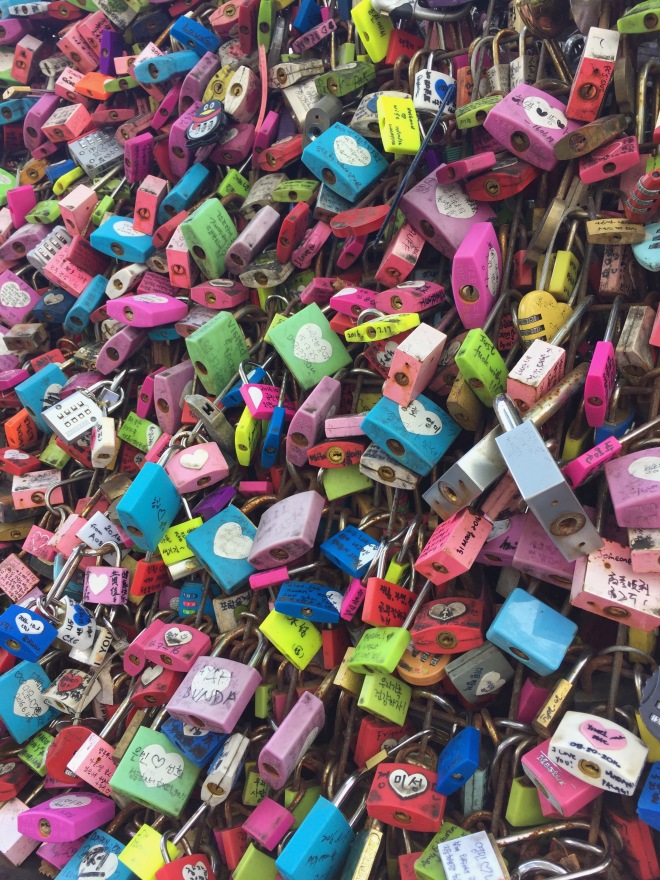Desperately trying to squeeze in seasonal activities before the fast approaching, bitterly cold winter, Molly and I set off into a chilly and mist filled morning – our destination, Namsan; an icon of Seoul and its distant past. It has been voted the most scenic location in the capital city and is even referenced in the national anthem. Needless to say, a big dog in Korean culture.
But sometimes it’s about the journey, not the destination.
The pavements were still and the roads were dead; the outside air made me wish I were still inside the warm throws of my duvet. This will be one of the warmer starts to a day that I will experience in the coming months, but I could still smell the cold and taste its sharpness. We trundled our way to the station against the backdrop of lush mountains, shaded with browning foliage – another sign that perhaps we had been optimistic about how fast the changing of seasons had been.

Two changes and a short hour later, we arrived at Myeondong station to the autumn sun breaking through the remaining mist and warming everything and anything. Betrayed by my forward thinking and regretting my thermal clothing, I dashed in to the coffee shop to re-adjust.
The sounds of the city faded away as we made our ascent through the quiet streets of Myeondong, towards the now visible Mt. Namsan. Sipping my coffee and eating a banana, I began to wonder when this would become like the arduous climbing I have become accustomed to in Korea.



At the threshold, where the city meets the mountain we entered into a park, where we were met by a group of elders engaged in a particularly prickly morning badminton doubles match. The relaxed atmosphere was rippled by a rather competitive man – his neon top leaped around as he took great joy in rallying his ageing partner and playing each point as if it was his last in a cup final.
Once the opponents submitted to the man’s clear desire to dominate, we set off along the neatly tarmacked road running up the mountain. An abundance of trees sits at the bottom of a steep and colossal staircase, and the rich earthy smell makes it feel like a countryside getaway in the sprawling city of Seoul. At 262m tall Mt. Namsan is metrically not overly impressive. It doesn’t even really qualify as a mountain by some standards, but this doesn’t stop it from looking and feeling like a mountain.
We joined the rest of the humans – from children barely able to walk up the challenging steps, to veteran silver foxes carrying a cheeky bottle of Makgeolli (milky rice wine) up with them. By our presence alone we had tacitly accepted the early morning ritual of escaping the city to rejuvenate and mark the end of the working week.
Running along the staircase, at convenient intervals up the trekking path, are photo points offering gorgeous and unrestricted views of the city below. From these viewpoints the sprawl of the historic city, with its unique topography, is a magnificent sight. I began to piece together why many people would make this climb a ritual.




At the top of Namsan Mountain we were joined by an injection of fresh blood that had decided to take the convenient cable car to the top. Venturing past the newly arrived we looked for a spot to rest our tired legs, but to our surprise we were met with a wooden and steel railed viewing platform covered in thousands of padlocks; finished off with one smug looking man selling an extensive range of locks. Varying in size, colour and shape the padlocks are part of the global phenomenon of couples locking their “love” to structures such as the Brooklyn Bridge, Rialto Bridge and the Pont des Arts.
Slightly further up, stands the YTN Seoul Tower. At a height of 236M the tall thin needle that pierces the Seoul skyline offers panoramic views of the city below. Shops, restaurants and bars dominate the base and 7 floors of the tower.

Korean Heritage; decision pending.
Beside the various commercial undertakings at the base of the tower, stood a mix of young and old Koreans waving long white banners and handing out pamplets in support of the remaining portions of Seoul’s old city walls being added to UNESCO’s World Heritage site list.
During the Joseon Dynasty (1392-1910), King Taejo commissioned a city wall as a defensive perimeter to unite the four inner mountains of Seoul; Baegaksan, Naksan, Inwangsan and Namsan. Numerous gates and light beacons are scattered along the wall, some still standing today, used for communication to and from the central government of the time.
The remnants of the unique city wall are undoubtedly a symbol of Korean pride, engineering and sovereignty stretching back from hundreds of years ago. Since 2012 they’ve been on the tentative list to be part of UNESCO’s World Heritage site list; a cause the group of people were still enthusiastically promoting during our journey up the historic mountain.


On the descent, we took an alternative, and less busy route than the one we used for our rise to the summit. This route offers a spectacularly peaceful and easy drop down to street level that runs alongside the famous old city wall, through a calming botanical garden, past the man practicing tai chi beside the outdoor gym and into the delightfully old neighbourhood of Sowol (more on this later).
